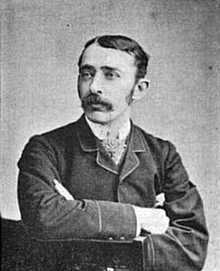
Back جون أمبروز فلمنج Arabic جون امبروز فلمنج ARZ Con Ambroz Fleminq Azerbaijani جان آمبروز فلمینق AZB Джон Амброуз Флеминг Bulgarian John Ambrose Fleming Catalan John Ambrose Fleming Czech John Ambrose Fleming German John Ambrose Fleming Spanish جان آمبروز فلمینگ Persian
John Ambrose Fleming | |
|---|---|
 Fleming in 1890 | |
| Born | 29 November 1849 Lancaster, Lancashire, England |
| Died | 18 April 1945 (aged 95) |
| Alma mater | University College London Royal College of Science |
| Known for | |
| Awards |
|
| Scientific career | |
| Fields | Physics |
| Institutions | |
| Doctoral advisor | Frederick Guthrie |
| Doctoral students | Harold Barlow |
| Other notable students | Hidetsugu Yagi Balthasar van der Pol |
Sir John Ambrose Fleming FRS[1] (29 November 1849 – 18 April 1945) was an English electrical engineer and physicist who invented the first thermionic valve or vacuum tube,[2] designed the radio transmitter with which the first transatlantic radio transmission was made, and also established the right-hand rule used in physics.[3]
He was the eldest of seven children of James Fleming DD (died 1879), a Congregational minister, and his wife Mary Ann, at Lancaster, Lancashire, and baptised on 11 February 1850.[4] A devout Christian, he once preached at St Martin-in-the-Fields in London on evidence for the resurrection.
In 1932, he and Douglas Dewar and Bernard Acworth helped establish the Evolution Protest Movement. Fleming bequeathed much of his estate to Christian charities, especially those for the poor. He was a noted photographer, painted watercolours, and enjoyed climbing the Alps.
- ^ Eccles, W. H. (1945). "John Ambrose Fleming. 1849-1945". Obituary Notices of Fellows of the Royal Society. 5 (14): 231–242. doi:10.1098/rsbm.1945.0014. S2CID 192193265.
- ^ Harr, Chris (23 June 2003). "Ambrose J. Fleming biography". Pioneers of Computing. The History of Computing Project. Retrieved 30 April 2008.
- ^ "Right and left hand rules". Tutorials, Magnet Lab U. National High Magnetic Field Laboratory. Retrieved 30 April 2008.
- ^ Brittain, J. E. (2007). "Electrical Engineering Hall of Fame: John A. Fleming". Proceedings of the IEEE. 95: 313–315. doi:10.1109/JPROC.2006.887329.